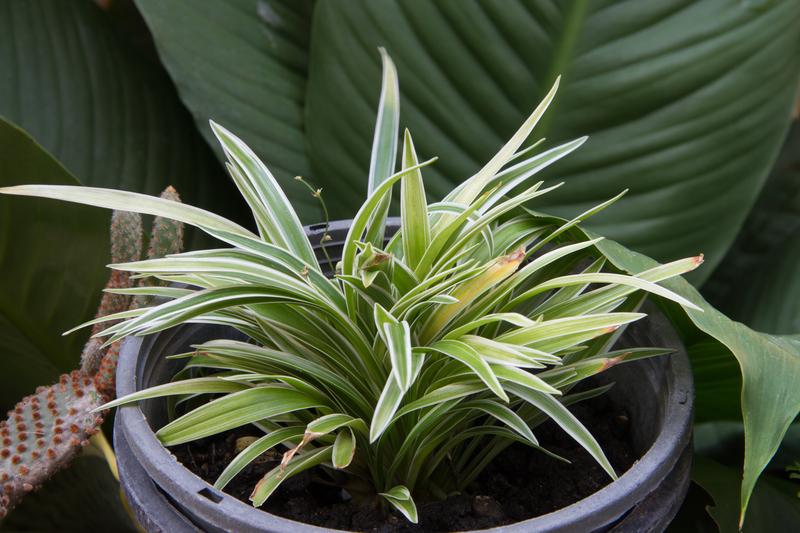Exploring the World of Vertical Gardening
Posted on 20/06/2025
Exploring the World of Vertical Gardening: Transforming Spaces, One Wall at a Time
Vertical gardening is revolutionizing the way we think about gardening and urban spaces. With growing environmental concerns and shrinking outdoor areas, vertical gardening provides innovative solutions for both homeowners and city dwellers. This comprehensive guide will take you on an exciting journey into the world of vertical gardening, showcasing its benefits, creative ideas, design tips, plant choices, and maintenance advice. Whether you are a beginner or a seasoned green thumb, exploring vertical gardens opens up a realm of possibilities for thriving, verdant environments--no matter how limited your horizontal space may be.

What is Vertical Gardening?
Vertical gardening, sometimes referred to as living walls or green walls, is the practice of growing plants on vertical surfaces, such as walls, trellises, or specially designed structures. Unlike traditional gardening, which spreads horizontally across ground or raised beds, vertical planting takes advantage of under-utilized vertical space. This approach enables urban gardeners, apartment dwellers, and those with limited yard space to grow a variety of plants in new, creative ways.
Key Features of Vertical Gardens
- Space Efficiency: Grow more in less space by utilizing walls and fences.
- Flexible Design: Install vertical gardens indoors, outdoors, on balconies, or in courtyards.
- Versatile Plant Choices: Support ornamental plants, edibles, herbs, succulents, and even trees (dwarf varieties).
- Low Maintenance (with planning): Certain setups require less weeding and pest control compared to ground beds.
Benefits of Vertical Gardening: Why Go Vertical?
As people increasingly prioritize sustainable living and urban greening, the benefits of vertical gardening are more relevant than ever. Here are some of the major advantages:
Maximizing Small Spaces
One of the biggest challenges facing modern gardeners is the scarcity of open land, especially in metropolitan areas. Vertical gardening makes it possible to cultivate lush greenery on patios, balconies, terraces, and even the tiniest apartments. By extending upward instead of outward, you can dramatically increase your plantable area.
Improving Air Quality
Vertical gardens help purify air by absorbing pollutants and emitting oxygen. Indoor living walls are especially effective at filtering volatile organic compounds (VOCs) and dust, promoting healthier environments for both homes and offices.
Enhancing Aesthetics and Well-being
A beautiful vertical garden transforms bland walls or uninspiring corners into vibrant, living artworks. Research shows that exposure to greenery can boost your mood, reduce stress, and enhance creativity--making vertical planting not just an architectural feature, but a wellness investment.
Boosting Biodiversity
Whether outdoors or on a balcony, a vertical green wall supports local pollinators like bees, butterflies, and birds. By integrating a variety of flowering and fruiting plants, you encourage diverse ecosystems--right outside your window.
Energy Savings and Climate Control
Vertical gardens act as natural insulation. Outdoor green walls can reduce building temperatures, shield structures from the sun's heat, and cut cooling costs. Indoors, plants naturally regulate humidity and temperature, making your space more comfortable year-round.
Choosing the Best Vertical Gardening System
There are numerous ways to build a vertical garden, from simple DIY setups to advanced hydroponic green walls. Selecting the right option depends on your space, budget, and goals.
Types of Vertical Gardens
- Wall Planters: Modular pockets, hanging pots, and recycled containers attached to walls. Affordable and customizable.
- Trellises & Lattices: Ideal for climbing plants like beans, peas, and jasmine. Great for patios and fences.
- Freestanding Towers & Columns: Self-supporting vertical planters or hydroponic towers--popular for herbs and vegetables.
- Living Wall Systems: Professional installations using felt, panels, or purpose-made trays with irrigation, suitable for large indoor or outdoor spaces.
Choose materials like wood, metal, or recycled plastics for frames. Always consider weight, durability, and water resistance--especially for outdoor projects.
Getting Started: DIY Vertical Gardening Ideas
Anyone can create a vertical garden, no matter their budget or skill level. Here are some inspiring DIY ideas to help you start vertical planting at home:
- Pallet Gardens: Repurpose wooden pallets by securing landscape fabric on the back and filling the slats with soil and plants.
- Hanging Bottle Gardens: Cut plastic bottles to form planters, string them on a sturdy wire or frame, and plant herbs or lettuce.
- Mason Jar Walls: Attach mason jars to boards or fences for a rustic, indoor herb garden.
- Shoe Organizer Planters: Fill fabric shoe organizers with soil, hang them on a wall, and plant shallow-rooted edible greens or flowers.
- Gutter Gardens: Mount old vinyl gutters in horizontal rows, perfect for strawberries or leaf lettuce.
With some creativity and basic tools, you can transform recycled materials into lush vertical gardens that beautify any space.
Selecting the Right Plants for Vertical Gardens
Not all plants thrive in vertical settings. Success depends on choosing vertical gardening plants that match your location's sunlight, moisture, and space conditions.
Best Plants for Vertical Gardens
- Herbs: Basil, parsley, thyme, mint, oregano, and cilantro are compact and flourish vertically.
- Leafy Greens: Lettuce, spinach, Swiss chard, kale, and arugula grow quickly and can be harvested frequently.
- Succulents: Low-maintenance and drought-tolerant, succulents like sedum, echeveria, and crassula add texture and color to vertical walls.
- Strawberries: Produce fruit even in hanging pockets or gutters.
- Ornamental Vines: Ivy, pothos, philodendron, and creeping fig create lush, cascading effects.
- Flowering Plants: Petunias, nasturtium, begonias, and fuchsia add visual interest and seasonal color.
Pro tip: For indoor living walls, stick with low-light plants such as ferns, pothos, and peace lilies. For outdoor vertical gardens with plenty of sun, opt for sun-loving edibles or drought-resistant species.
Designing Your Own Vertical Garden
Successful vertical garden design blends practical considerations with personal style. Keep these tips in mind:
Key Design Principles
- Assess Light Conditions: Choose plants and locations that match the available sunlight--north-facing walls often suit ferns and shade-lovers, while south-facing walls are ideal for sun-hungry edibles.
- Prioritize Access: Make sure you can reach all planters for watering, pruning, and harvesting.
- Plan Irrigation: Install a drip or soaker hose, or select self-watering planters for convenience and efficiency.
- Consider Structural Strength: Ensure your wall, fence, or structure supports the garden's fully saturated weight.
- Layer Plants: Arrange trailing, upright, and climbing plants for visual depth and efficient use of space.
Color, Texture, and Pattern
Mix bold foliage, varying leaf sizes, and staggered blooms for a truly eye-catching vertical display. Combine edible and ornamental plants for the ultimate art-meets-function effect.
- Experiment with symmetry or asymmetry for modern appeal.
- Use recycled materials for a trendy, eco-friendly aesthetic.
Maintaining Your Vertical Garden
Like all living installations, vertical gardens require thoughtful maintenance to thrive year-round. Fortunately, with the right setup, these gardens can be surprisingly low-maintenance.
Essential Maintenance Tips
- Watering: Vertical planters often dry out faster than ground-level beds. Check soil moisture regularly, and consider automated irrigation systems for larger installations.
- Fertilizing: Use slow-release fertilizers or diluted liquid feed to keep nutrient levels steady. Edible vertical gardens may need more frequent feeding.
- Pruning and Harvesting: Trim dead leaves, spent flowers, and overgrown stems to keep plants healthy and attractive.
- Inspect for Pests: Watch for signs of aphids, mites, or fungal diseases, especially indoors. Use organic solutions to manage infestations.
- Monitor Structure: Check mounts, supports, and containers for signs of wear, rot, or instability.
Regular attention ensures your vertical green wall stays lush and bountiful for years to come.
Sustainable Urban Living with Vertical Gardening
As cities become more crowded, vertical gardens offer tangible ecological and social benefits:
- Combat Urban Heat: Green walls absorb sunlight, mitigating the urban heat island effect and improving comfort.
- Manage Stormwater: Living walls intercept rainfall, slowing runoff and filtering pollutants.
- Promote Food Security: Community vertical farms produce fresh vegetables and herbs, reducing food miles and dependence on industrial agriculture.
- Enhance Public Spaces: Municipalities worldwide now adorn offices, shopping centers, and transit stations with vertical gardens, turning concrete jungles into vibrant oases.
For individuals, even a modest balcony vertical garden can foster a sense of connection to nature, support mental well-being, and provide homegrown food--not to mention add unique curb appeal.

The Future of Vertical Gardening: Innovations and Trends
From high-rise farms to biophilic architecture, vertical gardening is shaping tomorrow's cities. Leaders in sustainability are now experimenting with:
- Hydroponic Green Walls: Soil-less systems maximize yields in tight urban quarters and reduce water use.
- Automated Living Walls: Smart sensors and adaptive irrigation monitor plant health and optimize resources with minimal effort.
- Edible Living Facades: Buildings use walls filled with vegetables and herbs, providing food and natural insulation.
- Community Projects: Shared rooftop or wall gardens bring neighbors together, promoting sustainable food and green education.
As technology advances, vertical gardening will become more accessible, sustainable, and integral to healthier cities and homes.
Conclusion: Why You Should Explore Vertical Gardening Today
With its blend of practicality, beauty, and innovation, vertical gardening is more than a trend--it's a solution for the challenges of modern living. From tiny balcony herb walls to spectacular green facades in city centers, the possibilities are as varied as the plants themselves. By exploring the world of vertical gardening, you open your home and community to improved air quality, sustainability, beauty, and self-sufficiency. Start small or dream big--your vertical oasis awaits.
Ready to transform your space? Begin your vertical gardening journey today, and discover just how easy and rewarding it is to grow up!





